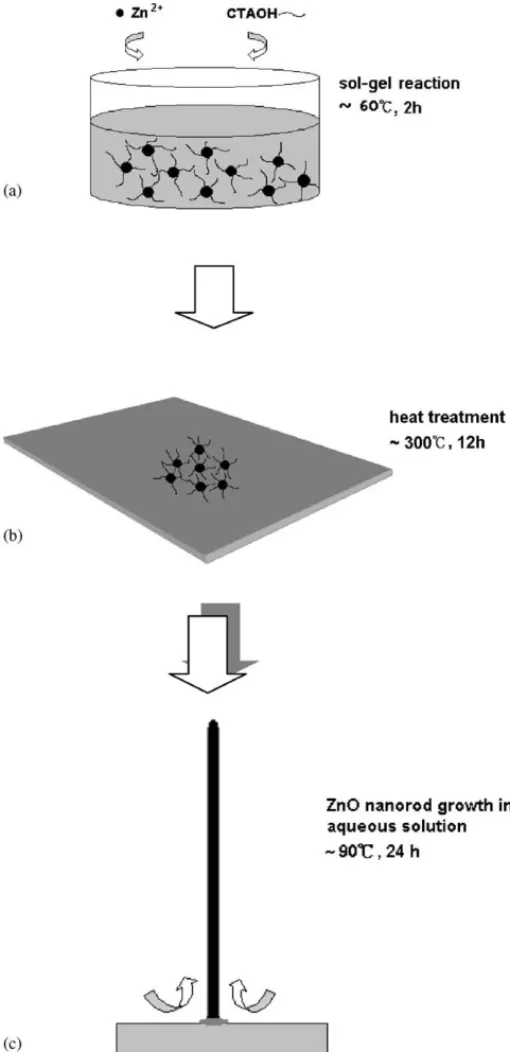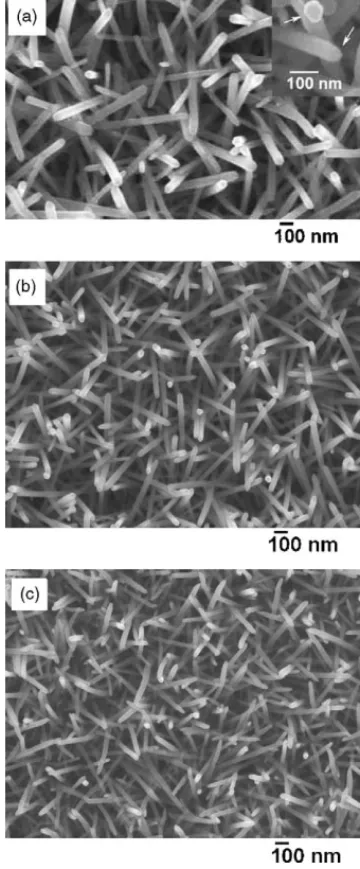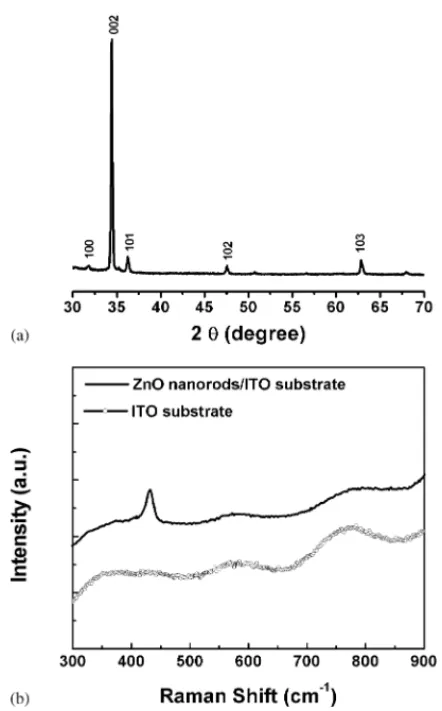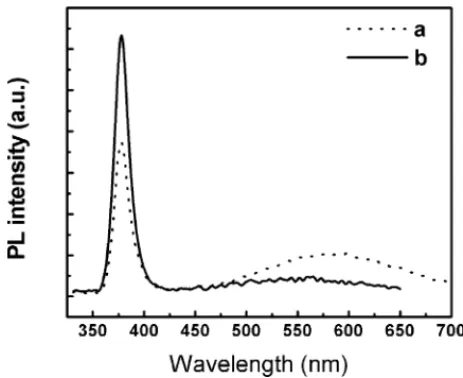A novel low-temperature growth and characterization
of single crystal ZnO nanorods
Chin-Hsien Hung, Wha-Tzong Whang
∗Department of Materials Science & Engineering, National Chiao Tung University, 1001 Ta Hsueh Road, Hsin Chu, Taiwan 300, PR China Received 4 April 2003; received in revised form 13 June 2003; accepted 20 June 2003
Abstract
One-dimensional (1D) single crystal ZnO nanorods directly grown on ZnO nanostructured substrates by soft chemical method is proposed. Employing a novel two steps procedure, the ZnO nanorods with a diameter about 45 nm can be successfully grown on substrate in aqueous solution at attractive low temperature in 90◦C, permitting large-scale fabrication with a relatively low cost and a potential application in optoelectronic nanodevices. The structures, appearances and optical properties of ZnO nanorods also have been characterized.
© 2003 Elsevier B.V. All rights reserved. Keywords: Zinc oxide; Nanorods
1. Introduction
Recently, one-dimensional (1D) nanoscale materials have received considerable attention due to their remarkable properties applied in optoelectronic and electronic nan-odevices [1,2]. Particularly, semiconductor nanomaterials, such as GaN [3], CdS[4], Si[5]and MnO2[6], have been
highly interested for the fundamental concepts of quantum size effect on optical, electrical and mechanical properties. Among them, ZnO notably possesses the unique properties such as wide direct-band gap (3.4 eV) and large exciton binding energy (60 meV) at room temperature, leading to a wide variety of potential applications in catalysts, gas sen-sors, piezoelectric devices, and solar cells[7,8]. Moreover, ZnO nanowire array is shown to have a UV-laser emission in the room temperature, as has been observed by Yang and co-workers [9]. Generally, 1D ZnO nanowhisker can be prepared by various methods, including using anodic alu-mina template [10], vapor–liquid–solid (VLS) mechanism
[11], metal-organic vapor-phase epitaxial growth (MOVPE)
[12,13]and common thermal evaporation method[14–17]. However, all the above methods always require quite ex-treme conditions and expensive equipments. Contrariwise, the soft chemical process provides a mild condition with a low-cost and well-controlled method to synthesize 1D nanoscale materials. Until now, the most effective ways
∗Corresponding author. Tel.:+886-3-571-2121; fax: +886-3-572-4727.
E-mail address: wtwhang@msn.com (W.-T. Whang).
to fabricate 1D ZnO nanostructures by employing soft so-lution process are micro-emulsions growth [18], thermal decomposition reaction in solvent[19]and spray pyrolysis
[20]. Although the soft chemical method can be used to grow 1D ZnO nanomaterials, however, most ZnO nanorods are randomly grown in the solutions, which limit their ap-plications in nanodevices. Recently, ZnO microrod arrays have been be produced by using soft chemical method[21], however, the preparation of small diameter nanorods (di-ameter<100 nm) with controlled nano-size nucleation are still highly required. Herein, we demonstrate an effective technique to directly grow single crystal ZnO nanorods on substrates with high density. Notably, we employ ZnO nanostructured (ZnO nanoparticles/ITO) substrates, as self-seeding to control ZnO nanorod growth, which not only has an attractive low-temperature (ca. 90◦C) feature but also prevents from using exotic metal as catalysts. The exclusion of exotic metal catalyst is very important for fabricating reliable nanodevices based on high quality 1D nanorods, because even very low impurity concentration of catalyst could dopant species into semiconductor nanorods and significantly affect the properties of nanodevices. In this study, the ZnO nanostructured substrate is shown to be helpful to the ZnO nanorods formation by soft solution method, and a novel two-step procedure is proposed. In the first step, uniform ZnO nanoparticle colloids were syn-thesized by sol–gel reaction. Second, ITO glass substrates covered with ZnO nanoparticle seeds were used to grow the nanorods from the hydrolysis–condensation of Zn2+ salt
0254-0584/$ – see front matter © 2003 Elsevier B.V. All rights reserved. doi:10.1016/S0254-0584(03)00331-6
Fig. 1. A schematic illustration for ZnO nanorod growth on nanos-tructured substrate by soft chemical method: (a–b) formation of ZnO nanoparticle colloids through sol–gel reaction and dispersion on ITO sub-strate; (c) the ZnO nanorods directly grow from the nanoparticles via hydrolysis–condensation process.
aqueous solution. The schematic diagram illustrating the ZnO nanorods formation processes is shown inFig. 1.
2. Experimental procedure
All the chemicals from Tokyo Chemical Industry were used as received without further purification.
2.2. Growth of ZnO nanorods
The ZnO nanoparticle colloids were directly dipped into ITO substrates and dried at room temperature. Be-fore growing nanorods, the nanostructured substrate was under the heat treatment in dry air at 300◦C for 12 h (Fig. 1(b)). Then ZnO nanostructured substrates were im-mersed in equimolar of zinc nitrate (Zn(NO)3·6H2O) and
methenamine (C6H12N4) aqueous solutions at 90◦C for
24 h to grow ZnO nanorods (Fig. 1(c)). Finally, the grown ZnO nanorods on nanostructured substrates was thoroughly washed with deionized water and allowed drying in air at room temperature.
The ZnO nanorods were further characterized and analyzed by scanning electron microscopy (SEM, Hitachi S-4700 FEG at 15 kV), Transmission electron microscopy (TEM, JOEL 2000FX at 200 kV), Philip Tecnai 20 high-resolution TEM (HRTEM) at 200 kV equipped with a GATAN digital photograph system and energy dispersion X-ray spectroscopy (EDS). The absorption spectrum was recorded by a HP8453 UV-Vis spectrometer. The Ra-man spectra were measured by Renishaw system 2000 micro-Raman spectrometer with a 514 Ar+ laser as exci-tation source. Photoluminescence (PL) spectra were also performed at room temperature using a He:Cd laser with a wavelength of 325 nm. An X-ray diffraction study of the samples was carried out with MAC Sience MXP18 X-ray diffractometer (30 kV, 20 mA) with copper targets at a scanning rate of 4◦min−1.
3. Result and discussion
3.1. Characterization of the ZnO nanoparticles
The UV-Vis absorbance spectrum of the ZnO nanopar-ticle colloids is shown in Fig. 2. The absorption spectrum shows a well-defined exciton band at 327 nm and significant blue shift relative to the bulk exciton absorption (373 nm)
[22]. This shift phenomenon mainly corresponds to the con-finement effect of the small size ZnO nanoparticle colloids (particle size ≤7 nm) [23]. According to the experimental relationship between the absorption shoulder (λ1/2) and the
Fig. 2. Absorption spectrum and TEM image (inset) of CATOH-capped ZnO nanoparticles.
particle size reported by Meulenkamp[24], the diameter dif-ference of the nanopartices during aging at 60◦C can be monitored. After aging for 2 h, the particles average diam-eter is estimated to∼3.6 nm, which consists with our TEM measurement. In the TEM image (shown in inset ofFig. 2), the nanoparticles are essentially monodispersed. Moreover, the nanoparticles are almost fully well separated, indicating that CTAOH surfactants efficiently cap on the particle sur-faces and successfully prevent the aggregation from sol–gel reaction.
3.2. Characterization of the as-grown ZnO nanorods Fig. 3 shows the typical field emission SEM images of ZnO nanorods grown on nanostructured substrate at 90◦C aqueous solution. The SEM images clearly show that straight nanorods can be grown on the whole substrate surfaces with high density. Although the nanorods are not perfectly aligned on the substrate, they have a tendency to grow per-pendicularly above the surfaces. The nanorods grown with 10× 10−3, 8.4 × 10−3and 6.8 × 10−3M Zn2+aqueous so-lutions at 90◦C for 24 h exhibit mean diameters of about 50, 45 and 40 nm, respectively (Figs. 3(a)–(c)). The diameters of nanorods grown at higher concentration (17×10−3and 20× 10−3M) increase to about 100 nm, implying that nanorods diameters strongly depend on the concentration of aqueous solution. Meanwhile, as shown in the inset ofFig. 3(a), the ZnO nanorod has a hexagonal prismatic cross-section and a hemispherical end. For identifying the growing sites of the nanorods on the nanostructured substrates, pure ITO sub-strates without ZnO nanoparticles were used with the same experimental conditions. However, quite barely nanorods are grown on the pure substrates indicating that ZnO nanoparti-cles obviously play a crucial role in the ZnO nanorod growth processes.
The crystal structure of as-grown ZnO nanorods was investigated using XRD (Fig. 4(a)). The [0 0 2] reflection apparently has sharpened up compared with the [1 0 1] maximum reflection of ZnO zincite (JCPDS 36-1451), indicating that the ZnO nanorods are grown with c-axis
Fig. 3. SEM image of ZnO nanorods grown in aqueous solution on the nanostructured substrate. The corresponding concentration of Zn2+ aqueous solution is (a) 10× 10−3, (b) 8.4 × 10−3and (c) 6.8 × 10−3M. The inset in Fig. 3(a)exhibits hexagonal prismatic cross-section and a hemispherical end.
orientation and trend perpendicular to the substrate sur-face.Fig. 4(b)shows Raman spectra of ITO substrates and ZnO nanorods grown on the substrates. Clearly, the ZnO nanorods have only one peak at 432 cm−1corresponding to ZnO optical phonons E2mode[25].
In order to characterize the ZnO nanorods, TEM was em-ployed to observe the nanorod microstructure. To prepare TEM samples, the nanorods were scraped from substrate by brief ultrasonication in methanol, and then dispersed onto a carbon film covered copper grid. InFig. 5(a), the bright-field TEM image of nanorods shows that the typical diame-ters and length-to-diameter ratios are about 50 and 25 nm, respectively. Notably, individual nanorod has one hemi-spherical end and another flat end in Fig. 5(a). Compared withFig. 3(a), we suggest that the nanorods could be grown
Fig. 4. (a) The XRD pattern and (b) Raman spectrum of the ZnO nanorods on ITO substrate.
from the well-defined faceted end to the hemispherical end, which is similar to the previous reports on the single crys-tal ZnO whiskers[26,18]. In addition, the EDS analysis of nanorods showed only contain Zn and O, indicating that there is no other metal impurity as catalysts. The HRTEM lattice fringes image and selected area electron diffrac-tion (SAED) pattern shown inFig. 5(b)reveal that, in this region, the nanorods possess a single crystal hexagonal structure without dislocations and stacking faults. The im-age also confirms that the nanorods grow along the [0 0 0 1] direction (indicated with an arrow).
Photoluminescence (PL) of the ZnO nanorods were measured in room temperature and the spectra were shown in Fig. 6. In Fig. 6(a), a sharp near band-edge emission at 378 nm and a broad green emission at ∼580 nm can be observed. The near band-edge emission is attributed to a well-known recombination of free excitons[27], and the green emission is resulted from the recombination of photo-generated hole with a singly ionized charge state of specific defect [28]. In addition, the heat-treatment step further decreases green emission intensity and increases band-edge emission intensity (Fig. 6(b)). This result can be attributed to that decrease in the amount of the singly ionized oxygen vacancies in the ZnO, so high crystal
Fig. 5. (a) TEM and select area diffraction image of single crystal ZnO nanorods grown in 10× 10−3M Zn2+ aqueous solution. The diffraction
pattern shows that the nanorod grows along [0 0 0 1] direction. (b, inset) High resolution TEM image obtained from the edge of an individual nanorod and its corresponding SAED pattern. The incident beam is along the zone axis.
quality of ZnO nanorods can be produced via high temper-ature heat-treatment processes.
In order to realize the influence of nanoparticles on the nucleation and growth of ZnO nanorods, more detailed experiments were carried out. First, the effects of vari-ous concentrations of the nanoparticles precursor were investigated. Experiment results show that the precursor concentration increases to ∼0.05 M, the average nanorods diameters and lengths increase to 70± 25 nm and ∼3 m (Fig. 7(a)). The diameter increasing could be attributed to the seeds aggregation, because high concentration precur-sors form bigger nanoclusters and large size seeds, subse-quently tend to the growth of coarser nanorods.Fig. 7(b)is the TEM image of such nanorods, showing that nanorods are straight along the longitudinal axis. Second, the lower
Fig. 6. PL spectra of: (a) before and (b) after heating at 350◦C for 12 h.
heat-treatment temperature for preparing the nanostructured substrates is found to decrease the nanorod diameters. As shown inFig. 8, when the substrate temperature was set to
∼250◦C, the diameters of bundle-like ZnO nanorods
de-crease to about 30 nm. Therefore, these preliminary obser-vations suggest that the ZnO nanoparticle play an important role in the formation of 1D ZnO nanorods.
Fig. 7. (a) SEM and (b) TEM images of the ZnO nanorods grown under same condition expect using nanoparticles precursor concentration of about 0.05 M.
Fig. 8. SEM image of the ZnO nanorods grown at the same condition but using the nanostructured substrate with low-heat treatment temperature of
∼250◦C.
Based on the above observations, ZnO nanoparticles are demonstrated to have an essential effect on ZnO nanorod formation. However, in the present two-step method, the nanorods formation above nanostructured substrates cannot be explained by the well-known vapor–liquid–solid growth mechanism [11] which a liquid metal droplet is located at the growth front. As a result, a possible explanation of the crystal ZnO (c-ZnO) nanorods growth was believed to be common crystal growth by solution chemistry. For the metal-oxide growth, nucleation always needs to overcome higher activation energy barrier, and the interface energy between c-ZnO/ITO substrate is usually smaller than that of c-ZnO/solution. As a result, the nuclei will trend to cre-ate on the ITO substrcre-ate than in the solution. Moreover, the nanoparticles on substrates could further lower the
c-ZnO/substrate interface energy barrier, so the nucleation
of ZnO nanorods can take place in lower saturation ratio. As the hydroxyl groups on ZnO nanoparticle surface form a ZnO/Zn(OH)2 core-shell nanostructure[29], electrostatic
absorption (binding) could promote to the metal-organic molecule, then anchoring on the nanoparticle surfaces. Upon the hydrolysis–condensation reaction, the as-prepared ZnO nanoparticles can serve as nuclei for the directly epi-taxial growth of ZnO nanorods because of the same crystal structure and lattice parameter. Compared with other reports
[11–17], it should be emphasized that much lower growth temperature in our method is of particular significance and can be very helpful to complex advanced nanodevice inte-gration where the conducting layer (such as metal) cannot survive at a high temperature.
4. Conclusions
In summary, a novel two-step procedure for prepar-ing large-scale growth of sprepar-ingle crystal ZnO nanorods on nanostructured substrates by soft solution method without metal catalyst is proposed. The low-temperature growth can be achieved via the help of ZnO nanostructured substrate which offers a desirable route for large-scale ZnO nanorods
Acknowledgements
The authors would like to thank H.G. Chen and Dr. C.L. Sun for their help in the HRTEM measurement and technical discussion. This research was supported by the National Science Council of the Republic of China under Grant NSC-912216E009013 and Lee and MTI center in NCTU on photonic devices and modules project.
References
[1] A.M. Morales, C.M. Libber, Science 279 (1998) 208.
[2] H. Dai, E.W. Wong, Y.Z. Lu, F. Shoushan, C.M. Libber, Nature 375 (1995) 769.
[3] W.Q. Ham, S.S. Fan, Q.Q. Li, Y.D. Hu, Science 277 (1997) 1287. [4] J.H. Zhang, X.G. Yang, D.W. Wang, S.D. Li, Y. Xie, Y.N. Xia, Y.T.
Qian, Adv. Mater. 12 (2000) 1348.
[5] J.H. Hu, T.W. Odom, C.M. Libber, Acc. Chem. Res. 32 (1999) 435. [6] X. Wang, Y. Li, J. Am. Chem. Soc. 124 (2002) 2880.
[7] L. Vayssieres, K. Keis, A. Hagfeldt, S.-E. Lindquist, Chem. Mater. 13 (2001) 4386.
[17] Y. Dai, Y. Zhang, Q.K. Li, C.W. Nan, Chem. Phys. Lett. 358 (2002) 83.
[18] L. Guo, Y.L. Ji, H. Xu, P. Simon, Z. Wu, J. Am. Chem. Soc. 124 (2002) 14864.
[19] J. Zhang, L.D. Sun, C.S. Liao, C.H. Yan, Chem. Commun. (2002) 262.
[20] O. Milosevic, D. Uskokovic, Mater. Sci. Eng. A 168 (1993) 249. [21] L. Vassieres, K. Keis, S.-E. Lindquist, A. Hagfeldt, J. Phys. Chem.
B 105 (2001) 3350.
[22] M. Haase, H. Weller, A. Henglein, J. Phys. Chem. 92 (1988) 482. [23] U. Koch, A. Fojtik, H. Weller, A. Henglein, Chem. Phys. Lett. 122
(1985) 507.
[24] E.A. Meulenkamp, J. Phys. Chem. B 102 (1998) 5566.
[25] X.L. Xu, S.P. Lau, J.S. Chen, G.Y. Chen, B.K. Tay, J. Cryst. Growth 223 (2001) 201.
[26] J.Q. Hu, Q. Li, N.B. Wong, C.S. Lee, S.T. Lee, Chem. Mater. 14 (2002) 1216.
[27] D.M. Bagnall, Y.F. Chen, Z. Zhu, T. Yao, M.Y. Shen, T. Goto, Appl. Phys. Lett. 73 (1998) 1038.
[28] K. Vanheusden, W.L. Warren, C.H. Seager, D.R. Tallant, J.A. Voigt, B.E. Gnade, J. Appl. Phys. 79 (1996) 7983.
[29] H. Zhou, H. Alves, D.M. Hofmann, W. Kriegseis, B.K. Meyer, G. Kaczmarzyk, A. Hoffmann, Appl. Phys. Lett. 80 (2002) 210.



